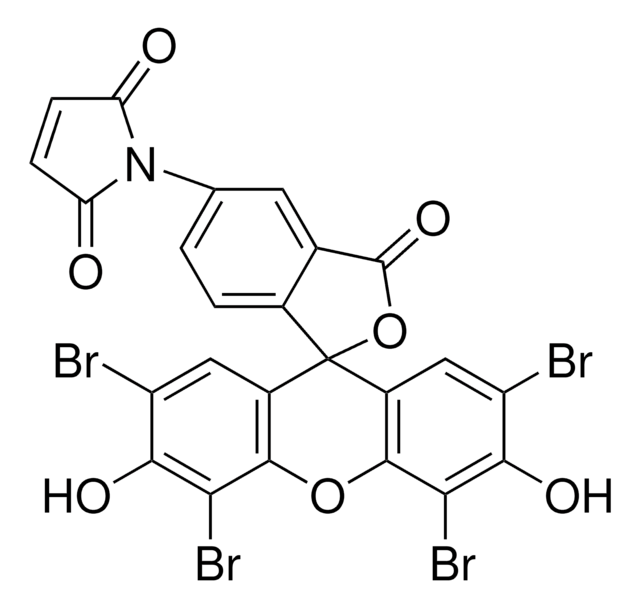71725
Sodium dodecyl sulfate
BioUltra, for molecular biology, ≥99.0% (GC)
동의어(들):
Dodecyl sodium sulfate, Dodecyl sulfate sodium salt, Lauryl sulfate sodium salt, SDS, Sodium lauryl sulfate
About This Item
추천 제품
Grade
for molecular biology
Quality Level
설명
anionic
제품 라인
BioUltra
분석
≥99.0% (GC)
형태
powder
분자량
micellar avg mol wt 18,000
응집 번호
62
불순물
DNases, none detected
RNases, none detected
insoluble matter, passes filter test
phosphatases, none detected
proteases, none detected
손실
≤3% loss on drying, 20 °C (HV)
CMC
7-10 mM (20-25°C)
mp
204-207 °C (lit.)
전이 온도
cloud point >100 °C
solubility
H2O: 0.1 M at 20 °C, clear, colorless
density
0.455 g/cm3
음이온 미량물
chloride (Cl-): ≤200 mg/kg
phosphate (PO43-): ≤1 mg/kg
양이온 미량물
Al: ≤5 mg/kg
Ba: ≤5 mg/kg
Bi: ≤5 mg/kg
Ca: ≤10 mg/kg
Cd: ≤5 mg/kg
Co: ≤5 mg/kg
Cr: ≤5 mg/kg
Cu: ≤5 mg/kg
Fe: ≤5 mg/kg
K: ≤200 mg/kg
Li: ≤5 mg/kg
Mg: ≤5 mg/kg
Mn: ≤5 mg/kg
Mo: ≤5 mg/kg
Ni: ≤5 mg/kg
Pb: ≤5 mg/kg
Sr: ≤5 mg/kg
Zn: ≤5 mg/kg
SMILES string
[Na+].CCCCCCCCCCCCOS([O-])(=O)=O
λ
0.1 M in H2O
UV 흡수
λ: 260 nm Amax: 0.04
λ: 280 nm Amax: 0.02
HLB
40
적합성
suitable for electrophoresis
InChI
1S/C12H26O4S.Na/c1-2-3-4-5-6-7-8-9-10-11-12-16-17(13,14)15;/h2-12H2,1H3,(H,13,14,15);/q;+1/p-1
InChI key
DBMJMQXJHONAFJ-UHFFFAOYSA-M
유사한 제품을 찾으십니까? 방문 제품 비교 안내
일반 설명
In protein biochemistry, SDS plays a pivotal role in protein extraction and SDS-PAGE (sodium dodecyl sulfate-polyacrylamide gel electrophoresis). Its ability to denature proteins by disrupting their secondary and tertiary structures allows for their uniform migration during gel electrophoresis, enabling the separation and analysis of proteins based on their molecular weight. This technique has become an indispensable tool for identifying and characterizing proteins in biological samples.
Beyond its role in protein analysis, SDS also finds utility in nucleic acid extraction and various hybridization techniques. Its detergent properties aid in the lysis of cells and the release of nucleic acids, facilitating their subsequent purification and analysis. Additionally, SDS is employed in hybridization techniques to promote the annealing of complementary nucleic acid strands, enabling the detection and analysis of specific DNA or RNA sequences.
애플리케이션
- as an ionic surfactant in polystyrene (PS) particle suspension for surfactant-based experiments
- in phosphate-buffered saline as a component of lysis buffer to homogenize myometrium and leiomyoma tissue
- as a component of lysis buffer to dissolve formazans
- as a component of high-salt nuclear extraction buffer
생화학적/생리학적 작용
특징 및 장점
- Suitable for molecular biology and biochemical research
- BioUltra grade for your sensitive applications
- Free from DNase, RNase, NICKase and protease
- Tested for trace levels of Anions and Cations
- Tested to confirm low levels of heavy metal contamination, ensuring suitability for various applications
- Undergoes hydrolysis at high temperatures, especially in acidic medium
기타 정보
신호어
Danger
유해 및 위험 성명서
Hazard Classifications
Acute Tox. 4 Inhalation - Acute Tox. 4 Oral - Aquatic Chronic 3 - Eye Dam. 1 - Flam. Sol. 2 - Skin Irrit. 2 - STOT SE 3
표적 기관
Respiratory system
Storage Class Code
4.1B - Flammable solid hazardous materials
WGK
WGK 2
Flash Point (°F)
338.0 °F
Flash Point (°C)
170 °C
개인 보호 장비
Eyeshields, Faceshields, Gloves, type P3 (EN 143) respirator cartridges
시험 성적서(COA)
제품의 로트/배치 번호를 입력하여 시험 성적서(COA)을 검색하십시오. 로트 및 배치 번호는 제품 라벨에 있는 ‘로트’ 또는 ‘배치’라는 용어 뒤에서 찾을 수 있습니다.
이미 열람한 고객
자사의 과학자팀은 생명 과학, 재료 과학, 화학 합성, 크로마토그래피, 분석 및 기타 많은 영역을 포함한 모든 과학 분야에 경험이 있습니다..
고객지원팀으로 연락바랍니다.




